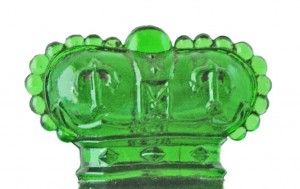The Crown Perfumery Company offered so much more than just fine perfumes. It was an extensive enterprise of feminine accessories. From its inception, they had a full range of toiletry products to complement their line of exquisite perfumes. As their perfume library grew, so too did their product line. Their toiletry line included bath powder, bath salts, brillantine’s, combs, creams, face powder, hair washes, pomades, sachets, shaving items, soaps, toilet waters, tooth brushes and toothpaste.
Today we cannot imagine a perfume house producing toothpaste. Scented soap, lotions, face powder and cold cream, yes these are within the realm, but not toothpaste. However, in the nineteenth century, it was not at all unusual for a perfume house to produce a range of toilet requisites, including perfumed cleansing hair lotions, hair coloring lotions and toothpaste. Guerlain, Ed. Pinaud, L.T. Piver and Rimmel all offered a range of toiletry products.
Crown toiletries received peer recognition at the international exhibitions. The 1876 United States Centennial International Exhibition in Philadelphia awarded a medal to The Crown Perfumery Company for their buffalo horn combs, which were praised for “their high degree of excellence in quality, style and general finish.” [15] Horn combs are highly regarded for they are rich in keratin and produce no static electricity. Crown had combs made from tortoise shell, buffalo horn and white horn.
Soaps were awarded prize medals in 1888 at Melbourne, 1886 at Adelaide and in 1893 at Chicago. Perfumed sachets were also recognized and awarded at Chicago in 1893.
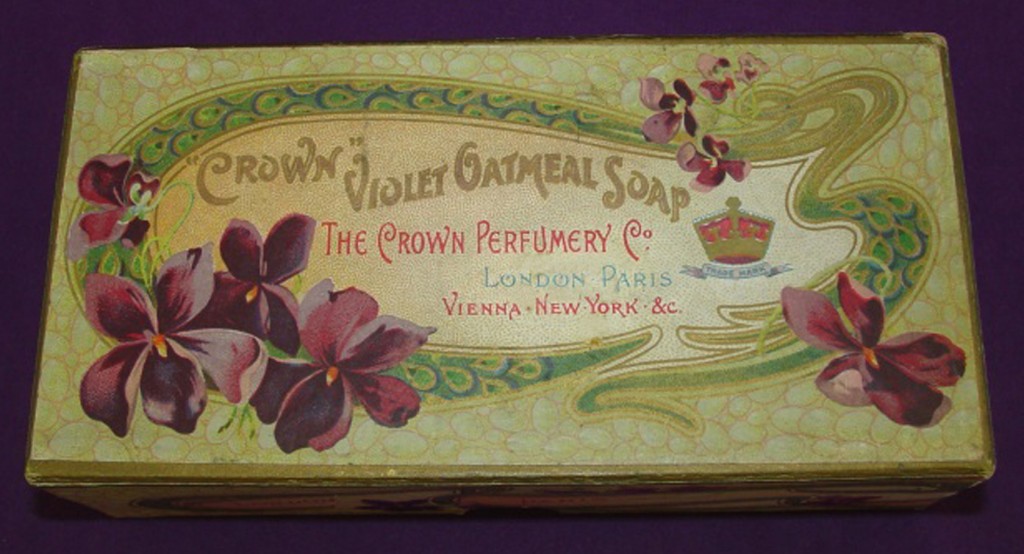
So extensive was their product range that articles were written describing window displays with either a range of Crown products or with a single Crown fragrance. These window displays caught the attention of customers and increased sales. One such article was written for the month of May — the month of violets. The description began with bunches of artificial violets placed in a large decorative flower pot in the center of a violet muslin cloth on the lowest shelf. Tiers of two or three shelves, also draped with the violet muslin cloth, were placed along the sides and in the back. Artistically arranged were the Crown violet perfumes and toiletry articles: Crown Violet, Violettes de Parme, Violette Printanière and Wood Violets, each series having different coloring and different labels. [16]
Many women enjoy being awash in one fragrance from head to toe. Crown accommodated these women beautifully. A perfumed line of soap and cosmetics shown with coordinating graphics and packaging to the perfume was known as a “perfumerie.” L. Legrand is credited with the first “perfumerie,” Oriza, in 1850. The Crown Perfumery Company had an extensive line of “perfumeries” over the years. They introduced their Opaline “perfumerie” in 1873, with perfumed face powder, toilet soap, toilet water and tooth paste. Opaline face cream, lotion for the hair, pomade and sachets were added later. In 1912, the Iroma line carried perfume, face powder, sachet, toilet soap, brillantine and lotion for the hair.
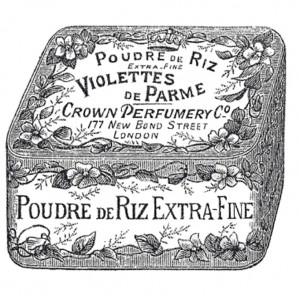
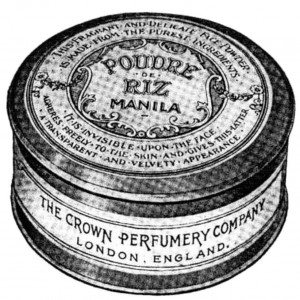
c. 1893 [17] c. 1916 [18]
Toilet Water and Florida Water were added to the bath as a fragrant, refreshing water softener. Eau de Cologne was not only used in the bath, it was used as a mouthwash and as a stimulating hair tonic.
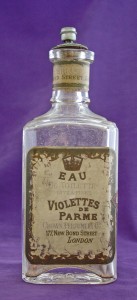
A wide range of products was offered for cleaning, coloring and controlling hair. Corofix, a non-greasy tonic, controlled frizzy and fine hair. For the most luxuriously soft hair that glistened, brillantine was used. Grey hair was not a preferable choice one hundred years ago. The Crown Hair Restorer was advertised to prevent grey hair and to restore grey hair to its natural color. Crown would use its extensive library to add fragrance to these products.
Cherry seems to have been a favorite Crown toothpaste. Prior to being placed in tubes, toothpaste came in round porcelain “pots” of two sizes. These shallow pots also held Ambrosial Cream for Shaving and Cold Cream.
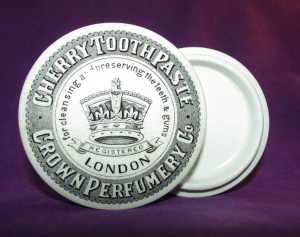
.
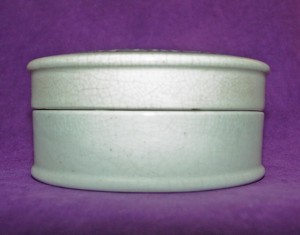
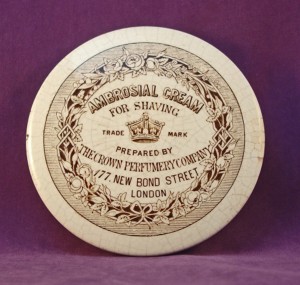
This 1872 patented lid design held Cold Cream of Roses in a round porcelain “pot.” The design was used for many other scented cold creams.
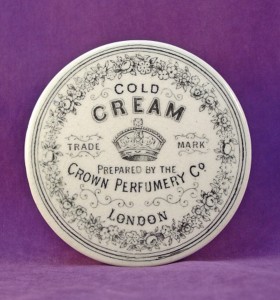
2.75″ / 6.9 cm diameter
This kidney shaped porcelain dish by Royal Doulton held a product scented with Crown White Violet – perhaps a body cream.
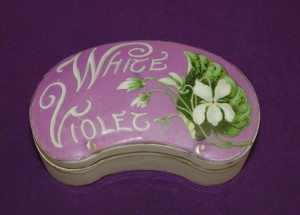
4″ / 10.2 cm long x 1.25″ / 3.1 cm high
The Crown Perfumery Company used the purest natural ingredients for their perfumes and for their toilet soaps — of which they had over 50 different items. Crown was using a cold press process, or “milling,” which eliminated moisture and created a dry, hard soap that retained its shape – oval or round. Their premium soap, English Roses, was a finely grained, rose-colored round soap, scented with Otto of Roses. It was a thick, round cake with a deeply embossed crown in the center. [19] Soap also came in a wooden bowl of “generous proportions,” accompanied by a bath brush of fine flexible fibers. Iroma, Violettes de Parme and Glycerin and Cucumber were the scents used in the wooden bowls.
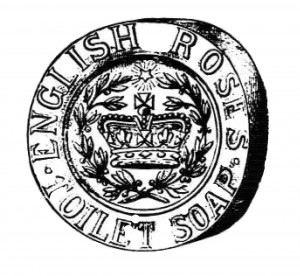
Their delicate face powder produced a velvety appearance and came in five tints (white, cream, rose, pink, Rachel). Rachel is a creamy-yellow color named for the talented French actress, Élisa Rachel Félix (1821-1858).
Then as now, small pillows filled with perfumed powder or fragrant herbs were a small luxury added to drawers and closets. In 1882, Crab Apple Blossoms powder was placed in a pale blue satin bag, with a lining of pink satin. Hand painted crab apple blossoms decorated the outside. Crown sold bottles of sachet powder to scent handkerchiefs, gloves and clothing.
Shaving soap, shaving sticks, shaving stands and sets were also sold. One such shaving set consisted of a cut glass jar with a silver lid, a round cake of shaving soap and a silver handled shaving brush.
And then we come to Bathodora, a delicate bath powder which created havoc between London and New York. The ensuing court cases were bitter and long.
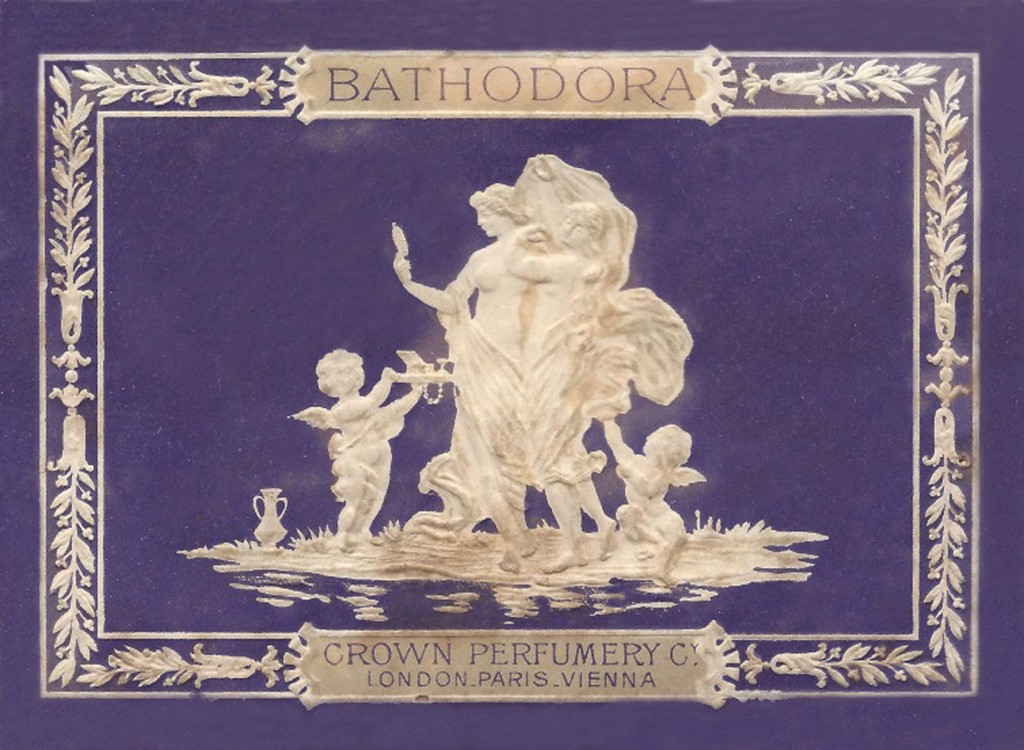
An embossed envelope of Bathodora, featuring a Wedgwood-style design
William Sparks Thomson and Charles H. Langdon were lifelong friends and business partners. When Charles H. Langdon retired from Langdon, Batcheller & Co. in 1893, Thomson lost someone he trusted. He did not trust George C. Batcheller even though the two had been business partners since 1870. An elderly Thomson was also winding down his business activities. In 1899, he signed a seven year contract with George C. Batcheller & Co. to handle products of The Crown Perfumery Company in the United States.
George C. Batcheller & Co. began importing perfumes and toiletries from London and Paris. A production facility was built to re-create a few of the London formulas with imported ingredients from London. Printed labels, boxes and advertising items were shipped from London and Paris.
Bathodora, a perfumed powder to soften the bath, was a London product selling very well – 24,000 packages in 1903. It was a white-as-snow and just-as-light powder scented with lavender, crab apple blossom, rose or violet. The cartons had a beautiful Wedgwood style design with embossing. Bathodora also came in round tins. Sample envelopes were mailed upon request.
When George C. Batcheller decided he could not produce the expensive Bathodora profitably, he chose a cheaper bath powder from his new manufacturing firm, Batcheller Importing Company. Bathasweet, selling at $0.25, became a rival to Bathadora, selling at $0.75. Thomson saw this new product as a rival to his own product and a breach of contract by Batcheller. William Sparks Thomson sought a legal solution. The court cases which ensued would end all association between the two men.
William Sparks Thomson died on November 27th, 1907. The contract with Batcheller ended in December 1907. Charles E. Thomson set about revitalizing the reputation of The Crown Perfumery Company in the United States. Mary H. Sanders was hired to manage the American market from New York. In March of 1908, an advertising campaign blitz began, specifically showing Crown Lavender Salts, Crab Apple Blossoms and Bathodora. New perfume series were added and soon high-class drug and department stores were briskly selling high quality Crown Perfumery products once more.
William, Annie and Charles Thomson sold The Crown Perfumery Company to William Gossage & Sons, Ltd. in 1921.
That same year was the introduction of The Crown Toilet Dainties. In bold red and gold lacquer packaging, this very successful line consisted of vanishing cream, complexion powder, talcum powder, toothpaste, tooth powder, Corodenta (for cleansing dental plates), brillantine (solid and liquid), shaving powder and a shaving stick. The items were purchased separately or in metal box sets. Advertisements for Crown Toilet Dainties proclaimed that a more artistic, neater look to a woman’s dressing table was achieved with this harmonious set.
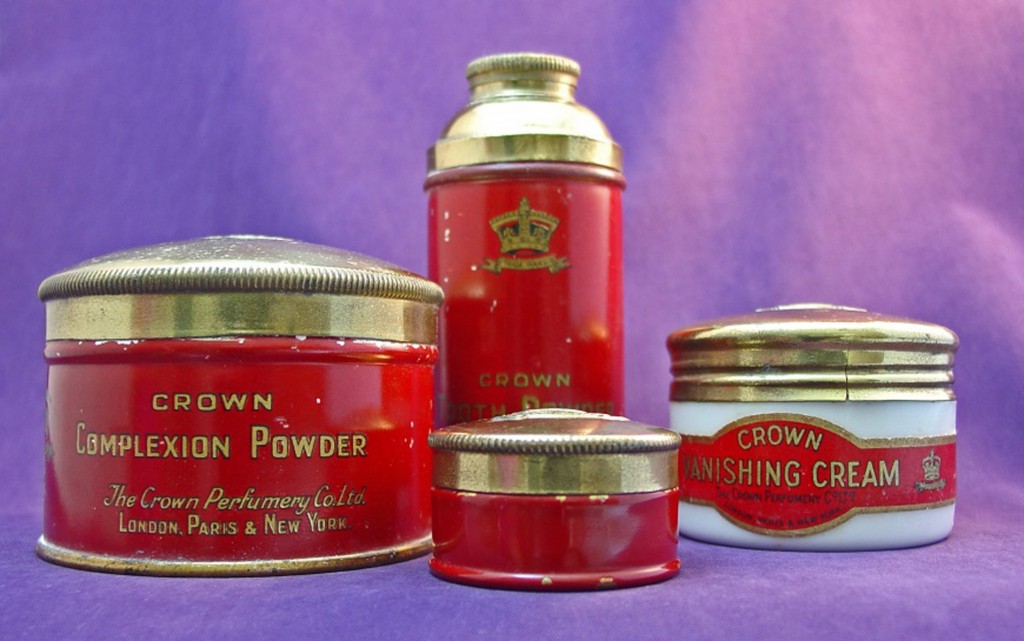
A device for dispensing talcum powder was first patented in the U.K. in 1924, with patents in France and Germany to follow. With the press of fingers, the Crown TalcPuf released a fine spray of Crown Talcum Powder onto the face or body.
[15] United States Centennial Commission. International Exhibition. 1876. Reports and Awards. Vol. IV, Groups III-VII. Edited by Francis A. Walker. Washington: Government Printing Office, 1880.
[16] American Druggist and Pharmaceutical Record. 24 August 1893, 114.
[17] The Pharmaceutical Era. 1 December 1893, 34.
[18] American Druggist and Pharmaceutical Record. June 1916, 69.
[19] Chemist and Druggist. 14 December 1889, 828.
